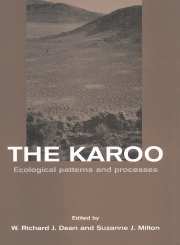Book contents
- Frontmatter
- Contents
- List of contributors
- Foreword
- Preface
- Acknowledgements
- Part one Biogeographic patterns and the driving variables
- Part two Form and function
- Part three Dynamics
- Part four Human impacts
- Part five Comparisons
- 18 Comparison of ecosystem processes in the Nama-karoo and other deserts
- 19 The succulent karoo in a global context: plant structural and functional comparison with North American winter-rainfall deserts
- 20 The karoo: past and future
- References
- Index
18 - Comparison of ecosystem processes in the Nama-karoo and other deserts
Published online by Cambridge University Press: 23 December 2009
- Frontmatter
- Contents
- List of contributors
- Foreword
- Preface
- Acknowledgements
- Part one Biogeographic patterns and the driving variables
- Part two Form and function
- Part three Dynamics
- Part four Human impacts
- Part five Comparisons
- 18 Comparison of ecosystem processes in the Nama-karoo and other deserts
- 19 The succulent karoo in a global context: plant structural and functional comparison with North American winter-rainfall deserts
- 20 The karoo: past and future
- References
- Index
Summary
Introduction
Most comparisons of deserts have focussed on convergent evolution of plants and animals and their adaptations to life in an extreme, hot, dry environment (Louw and Seely, 1982). There has been less attention focussed on the structural and functional comparisons of ecosystems. The synthesis volumes produced as a result of the US–IBP Desert Biome Program were primarily data summaries with limited comparisons upon which to generalize the research findings in one desert to other deserts of the world. This chapter concentrates on comparisons of ecosystem processes and some of the structural features that affect these processes. The ecosystem processes compared here are primarily those at the patch scale but, where possible, comparisons will be made at the watershed or landscape unit scale.
At the smallest scale are patches formed by individual perennial plants or groups of plants and the unvegetated spaces between these patches. Subpatterns within these patches are developed by the responses of ephemeral plants to seasonal rainfall and to soil heterogeneity resulting from perennial plant–soil interactions. Soil surface characteristics that affect erosion potential are also a product of the plant–soil interactions, such as spacing of vegetated patches, plus other interactions, such as distribution and type of disturbance by animals. Variables that affect pattern at this scale include (1) efficacy and characteristics of water redistribution, (2) redistribution of organic debris, (3) abundance and spatial–temporal distribution of animal-produced soil disturbance patches, (4) soil surface characteristics (cryptogamic crusts, rocky pavement, litter cover etc.)
Water and nutrients are the essential resources for all ecosystems and, in terrestrial ecosystems, the availability of these essential resources is a function of the characteristics of the soil.
- Type
- Chapter
- Information
- The KarooEcological Patterns and Processes, pp. 291 - 302Publisher: Cambridge University PressPrint publication year: 1999
- 3
- Cited by

